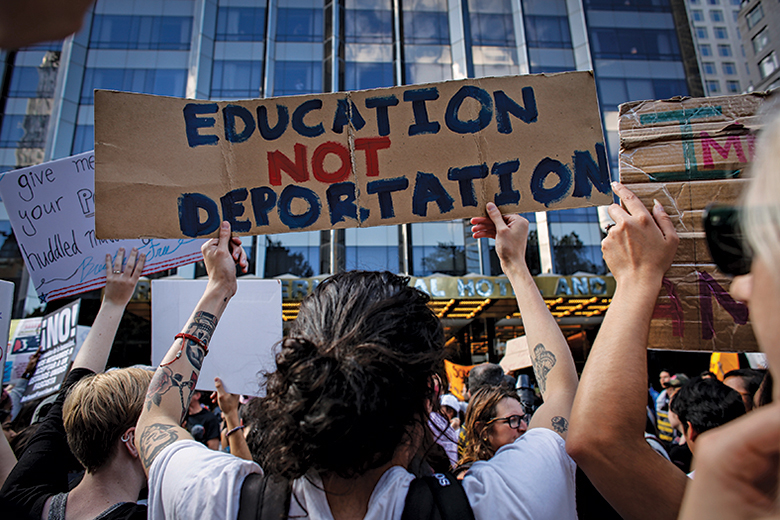In December, Andrea Ramos Fernandez is supposed to graduate from the University of Texas at San Antonio with a bachelor’s degree in public administration. The last stretch of any student’s undergraduate degree is usually a stressful yet thrilling time as they start to look forward to the next stage of their life. But despite four years of studying and working as a community organiser in the city, planning for the future is a luxury that Ms Fernandez does not have: she is not even sure if she will be able to stay in the country after August.
Ms Fernandez was brought to the US from Mexico when she was eight years old. She is currently protected from deportation and allowed to work through the Deferred Action for Childhood Arrivals programme.
But like the rest of the estimated 700,000 Daca recipients in US, Ms Fernandez’s future in the country sits in the hands of Congress, which has been charged by Donald Trump with finding a solution to the country’s creaking immigration system by 5 March.
“It is a really stressful thing to deal with; I can’t plan ahead in my life in two-year increments,” Ms Fernandez told Times Higher Education.
In September 2017, the Trump administration announced that it would rescind the Daca programme and would not accept any new applications. Current permit holders would be allowed to renew their status (which is valid for two years) only if it expired before 5 March.
The move was met by a series of lawsuits filed by state governments and other organisations, and in January, a federal judge issued an injunction ordering the government to continue accepting renewal applications nationwide while these lawsuits proceeded.
The injunction meant that people such as Ms Fernandez, whose permit expires in August, could apply for renewals.
But little progress has been made towards finding a permanent solution to undocumented immigrants in the country, and negotiations between Democrats and Republicans have repeatedly broken down.
The average age of Daca recipients is 24, and the Migration Policy Institute estimates that about 20 per cent of all participants are enrolled in post-secondary education nationally – about 140,000 students. The MPI estimates that a further 400,000 unauthorised immigrants aged between 18 and 24 are enrolled in colleges and universities.
Texas has the second highest number of Daca recipients, about 113,000, behind California with 198,000. Similar to California, Daca students in Texas are eligible to pay in-state tuition fees, may receive state financial aid and can work. But the state’s politics are notoriously less friendly towards undocumented immigrants and influence how higher education institutions in the state support these students.
The governor, Greg Abbott, has threatened to cut state funding for any university that declares itself a sanctuary campus, while the state’s attorney general, Ken Paxton, led the coalition of nine other attorneys general and the governor of Idaho that convinced Mr Trump to end the Daca programme.
At the recent academic affairs meeting of the American Association of State Colleges and Universities, held in San Antonio, sector leaders from around the state spoke of the “fine line” they walk between wanting to communicate to undocumented students that they have options and not drawing too much political attention to their institution or putting those students on the radar of immigration enforcement.
One delegate from a campus in southern Texas reported seeing an increase in the number of border patrol agents around the city and said that the university had not provided any Daca information sessions on campus “because we don’t know how to advertise them and our students would be afraid to show up”.
Danny Anderson, president of Trinity University, a small private liberal arts college in San Antonio, said that he had resisted taking an activist stance on the issue. “My main thinking has been I have no legal standing where I could offer any kind of protection to any individual and that I am misleading them publicly if I were to pretend that I could do that.”
The Brownsville campus of the University of Texas Rio Grande Valley, which opened in 2013 and already serves more than 27,000 students, 89 per cent of whom are Hispanic, sits less than a mile from the border with Mexico. Kristin Croyle, its vice-president of student success, acknowledged that “dealing with undocumented students in California would be easier because of the political environment”.
Dr Croyle added that the uncertainty around Daca weighs heavily on students’ minds. “It’s hard to stay focused on what, as a student, they should be focused on right now when there are so many voices that make it sound like the doors for opportunity will be closed for ever,” she said.
The consequences of taking a stand on the deeply partisan issue of immigration could be career-ending for university leaders. In January, Charles Wright resigned as president of Weber State University in Utah after receiving heavy criticism for writing in an email to the university community, “We respectfully urge the Trump administration to reconsider the recent executive order on immigration and reopen our country’s doors to the many international visitors and refugees who help make our nation and university great.”
Nevertheless, protecting Dreamers was one of the strategic priorities set out by Taylor Eighmy when he became president of UTSA in the summer of 2017. With more than 30,000 students, UTSA is San Antonio’s largest higher education provider and, like every other university in the country, it has no idea how many Daca or undocumented students it has enrolled.
“It’s on everybody’s mind right now that the Daca situation is unresolved,” Professor Eighmy told THE. “We spend a lot of time discussing that, and we spend a lot of time advocating for our students.”
In January, Professor Eighmy worked with UTSA’s immigrant youth leadership group to open Texas’ first Dreamers Center, modelled on a similar initiative at the University of California, Berkeley.
“The students really like the idea that the institution would stand up a physical centre that they could visit to get information and find resources and [learn] how we might refer them to legal counsel here in the city to advise them,” Professor Eighmy said. “It’s really emblematic of our compassion for this very important group of students that are here and that are contributing so much to our fabric of what we do as a university.”
Ms Fernandez, who is the coordinator of UTSA’s immigrant youth leadership group, said that she was frustrated that other Texas institutions were not doing more to meet the “special needs” of undocumented students.
“Those students did not apply, did not get an admission status, did not get accepted into those universities and start paying tuition for them not to be able to receive resources that are going to make them successful at those universities,” she argued.
If Congress fails to come to an agreement on Daca by 5 March, the programme will slowly wind down as permits expire and work rights are revoked.
The January court injunction could offer temporary protection to those who moved to renew their applications, like Ms Fernandez, provided that it is not overruled by the Supreme Court. Even then, the action would offer little reprieve from the uncertainty of the future.
“If we don’t get a permanent solution, basically I’m going to be in the same spot two years from now when my permit will expire again,” she said.
In the worst-case scenario, Ms Fernandez and all the hundreds of thousands of Daca recipients will lose their protection from delayed deportation and could be sent to the nations that the federal government considers to be their “home”.
“Even though this isn’t my country, this is where I’ve grown up. It would hurt so much to leave, but my life isn’t over even if I were to get deported,” Ms Fernandez said defiantly. “The one thing they can never take away from me is my knowledge and any bit of education that I have gained from this country.”
sara.custer@timeshighereducation.com

Who are the ‘Dreamers’?
Barack Obama created the Deferred Action for Childhood Arrivals programme in 2012 after Congress failed to pass the Dream Act, which would have offered a path to citizenship to immigrants brought into the country illegally as children. He said that it was a “stop-gap measure” to find a solution to the estimated 11 million unauthorised immigrants in the US.
The Daca programme defers deportation proceedings for two years and allows participants to work. The permit can be renewed every two years.
To qualify, applicants have to meet a series of requirements, including having been under the age of 16 when they entered the US, being in school or having graduated or completed high school, and having no criminal history.
The Trump administration announced on 5 September 2017 that it would wind down the programme and would stop accepting new applications. Only participants whose permit expired before 5 March 2018 could apply for renewal, giving Congress six months to find a solution. In January, a federal judge said that the government must accept renewal applications for permits that expire after 5 March but it made no allowances for new applicants.
According to the Migration Policy Institute, there are at the moment about 690,000 Daca participants. It estimates that 20 per cent are enrolled in higher education and about 9,000 are employed as teachers or similar education professionals. Women in the programme are more likely to be enrolled in college than men (20 per cent versus 15 per cent).
There are eight Dreamers Resource Centers at university campuses in California and one in Texas; they support thousands of Daca and undocumented students. In 2016, the University of California system committed $25.2 million (£18.1 million) over three years to fund legal advice and Dreamers Centers. A tranche of $8.4 million will be dedicated annually to loans for undocumented students in the UC system.
Register to continue
Why register?
- Registration is free and only takes a moment
- Once registered, you can read 3 articles a month
- Sign up for our newsletter
Subscribe
Or subscribe for unlimited access to:
- Unlimited access to news, views, insights & reviews
- Digital editions
- Digital access to THE’s university and college rankings analysis
Already registered or a current subscriber?








